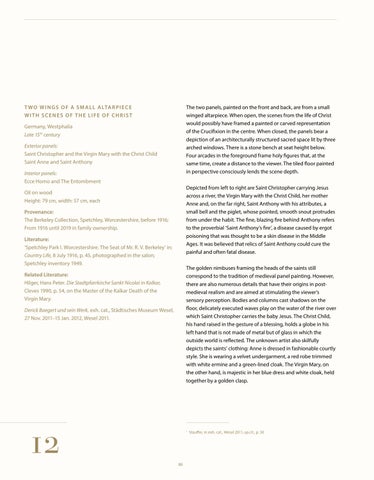T W O W I N G S O F A S M A L L A LTA R P I E C E WITH SCENES OF THE LIFE OF CHRIST
The two panels, painted on the front and back, are from a small winged altarpiece. When open, the scenes from the life of Christ would possibly have framed a painted or carved representation of the Crucifixion in the centre. When closed, the panels bear a depiction of an architecturally structured sacred space lit by three arched windows. There is a stone bench at seat height below. Four arcades in the foreground frame holy figures that, at the same time, create a distance to the viewer. The tiled floor painted in perspective consciously lends the scene depth.
Germany, Westphalia Late 15 th century Exterior panels: Saint Christopher and the Virgin Mary with the Christ Child Saint Anne and Saint Anthony Interior panels: Ecce Homo and The Entombment
Depicted from left to right are Saint Christopher carrying Jesus across a river, the Virgin Mary with the Christ Child, her mother Anne and, on the far right, Saint Anthony with his attributes, a small bell and the piglet, whose pointed, smooth snout protrudes from under the habit. The fine, blazing fire behind Anthony refers to the proverbial ‘Saint Anthony’s fire’, a disease caused by ergot poisoning that was thought to be a skin disease in the Middle Ages. It was believed that relics of Saint Anthony could cure the painful and often fatal disease.
Oil on wood Height: 79 cm, width: 57 cm, each Provenance: The Berkeley Collection, Spetchley, Worcestershire, before 1916; From 1916 until 2019 in family ownership. Literature: ‘Spetchley Park I. Worcestershire. The Seat of Mr. R. V. Berkeley’ in: Country Life, 8 July 1916, p. 45, photographed in the salon; Spetchley inventory 1949.
The golden nimbuses framing the heads of the saints still correspond to the tradition of medieval panel painting. However, there are also numerous details that have their origins in postmedieval realism and are aimed at stimulating the viewer’s sensory perception. Bodies and columns cast shadows on the floor, delicately executed waves play on the water of the river over which Saint Christopher carries the baby Jesus. The Christ Child, his hand raised in the gesture of a blessing, holds a globe in his left hand that is not made of metal but of glass in which the outside world is reflected. The unknown artist also skilfully depicts the saints’ clothing: Anne is dressed in fashionable courtly style. She is wearing a velvet undergarment, a red robe trimmed with white ermine and a green-lined cloak. The Virgin Mary, on the other hand, is majestic in her blue dress and white cloak, held together by a golden clasp.
Related Literature: Hilger, Hans Peter. Die Stadtpfarrkirche Sankt Nicolai in Kalkar, Cleves 1990, p. 54, on the Master of the Kalkar Death of the Virgin Mary. Derick Baegert und sein Werk, exh. cat., Städtisches Museum Wesel, 27 Nov. 2011–15 Jan. 2012, Wesel 2011.
12
1
88
Stauffer, in exh. cat., Wesel 2011, op.cit., p. 50














